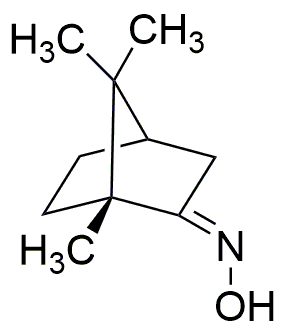(1R)-Camphor oxime is widely utilized in research focused on:
- Pharmaceutical Development: It serves as an intermediate in the synthesis of various pharmaceuticals, enhancing the efficacy of active ingredients.
- Fragrance Industry: This compound is used in the formulation of fragrances, providing a unique scent profile that is appealing in perfumes and personal care products.
- Polymer Chemistry: It acts as a stabilizer in certain polymer formulations, improving the durability and performance of plastics used in various applications.
- Analytical Chemistry: Researchers utilize it in analytical methods to detect and quantify other compounds, aiding in quality control processes in laboratories.
- Biochemical Research: It is employed in studies related to enzyme inhibition, contributing to the understanding of biochemical pathways and potential therapeutic targets.
General Information
Properties
Safety and Regulations
Applications
(1R)-Camphor oxime is widely utilized in research focused on:
- Pharmaceutical Development: It serves as an intermediate in the synthesis of various pharmaceuticals, enhancing the efficacy of active ingredients.
- Fragrance Industry: This compound is used in the formulation of fragrances, providing a unique scent profile that is appealing in perfumes and personal care products.
- Polymer Chemistry: It acts as a stabilizer in certain polymer formulations, improving the durability and performance of plastics used in various applications.
- Analytical Chemistry: Researchers utilize it in analytical methods to detect and quantify other compounds, aiding in quality control processes in laboratories.
- Biochemical Research: It is employed in studies related to enzyme inhibition, contributing to the understanding of biochemical pathways and potential therapeutic targets.
Documents
Safety Data Sheets (SDS)
The SDS provides comprehensive safety information on handling, storage, and disposal of the product.
Product Specification (PS)
The PS provides a comprehensive breakdown of the product’s properties, including chemical composition, physical state, purity, and storage requirements. It also details acceptable quality ranges and the product's intended applications.
Certificates of Analysis (COA)
Search for Certificates of Analysis (COA) by entering the products Lot Number. Lot and Batch Numbers can be found on a product’s label following the words ‘Lot’ or ‘Batch’.
Numéro de catalogue
Numéro de lot/série
Certificates Of Origin (COO)
This COO confirms the country where the product was manufactured, and also details the materials and components used in it and whether it is derived from natural, synthetic, or other specific sources. This certificate may be required for customs, trade, and regulatory compliance.
Numéro de catalogue
Numéro de lot/série
Safety Data Sheets (SDS)
The SDS provides comprehensive safety information on handling, storage, and disposal of the product.
DownloadProduct Specification (PS)
The PS provides a comprehensive breakdown of the product’s properties, including chemical composition, physical state, purity, and storage requirements. It also details acceptable quality ranges and the product's intended applications.
DownloadCertificates of Analysis (COA)
Search for Certificates of Analysis (COA) by entering the products Lot Number. Lot and Batch Numbers can be found on a product’s label following the words ‘Lot’ or ‘Batch’.
Numéro de catalogue
Numéro de lot/série
Certificates Of Origin (COO)
This COO confirms the country where the product was manufactured, and also details the materials and components used in it and whether it is derived from natural, synthetic, or other specific sources. This certificate may be required for customs, trade, and regulatory compliance.


